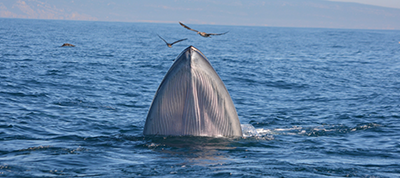The year 2025 can be considered, for Bolhas Tours, one of the most remarkable in terms of the diversity of species observed, providing records of scientific value and added tourist interest.
In addition to the usual sightings of common dolphins (Delphinus delphis) and bottlenose dolphins (Tursiops truncatus), three species rarely seen in the Sesimbra region were recorded: the short-finned pilot whale (Globicephala macrorhynchus), also known as the tropical pilot whale, Bryde’s whale (Balaenoptera brydei), and Sowerby’s beaked whale (Mesoplodon bidens).
Pilot whales, belonging to the genus Globicephala, include two species — the long-finned pilot whale (Globicephala melas) and the short-finned pilot whale (Globicephala macrorhynchus) — both known for their gregarious behaviour and strong social cohesion.
The short-finned pilot whale feeds mainly on squid, supplementing its diet with fish and octopus, and performs deep dives that can reach 1,000 meters. It’s a large oceanic dolphin, popularly referred to as a whale due to its size, which can reach 7.3 meters in length. It has a robust, hydrodynamic body, a rounded head and a curved dorsal fin, with a dark grey coloration and lighter tones on the ventral region.
During Bolhas Tours’s daily tours, this species was sighted between August and September in groups of around 40 individuals — a remarkable event for those who had the privilege to witness it and a scientifically relevant record. Sightings of this species have historically been documented at more southerly latitudes, never so far north of its usual distribution range, a fact that warrants further investigation.
Bryde’s whale (Balaenoptera brydei) stands out as one of the least known rorquals and exhibits a distinctive morphological feature: three parallel longitudinal ridges on the rostrum, whereas all other rorqual species have only a single central ridge. Its length ranges between 14–16 meters, and it can weigh up to 40 tones.
It shows a general tendency for seasonal migration, moving towards areas near the equator during winter and towards higher latitudes in summer. However, this species maintains a year-round presence in tropical and warm-temperate waters, favoring regions where sea temperatures remain above 16°C.
Its diet consists mainly of small pelagic fish, crustaceans and squid. Its feeding strategy relies on filtering large volumes of water using its keratinous baleen plates to retain prey. This species was frequently observed feeding through lunge feeding, a method involving rapid forward surges into dense prey aggregations, allowing efficient food capture in short periods of time.
VÍDEO: https://youtu.be/Vo5LL7R6gUc
During Bolhas Tours’s daily tours, this cetacean species was observed in August and October, often feeding in the same areas, highlighting the richness and abundance of food resources in the Sesimbra region.
Little is known about beaked whales. Some species have never been documented alive and are known exclusively from occasional stranding records. Others are only sporadically observed, and most display highly discreet and elusive behaviour, remaining at great depths for long periods and far from coastal areas.
Sowerby’s beaked whale (Mesoplodon bidens) belongs to the family Ziphiidae, which includes 23 species distributed across six genera: Mesoplodon, Ziphius, Hyperoodon, Berardius, Tasmacetus and Indopacetus.
This species is a deep-diving predator that feeds mainly on squid and small fish. It’s distinguished by its characteristic frontal cranial protuberance (located in front of the blowhole), its fusiform body with an elongated beak, and a small dorsal fin positioned towards the posterior part of the body. Adult males have two visible triangular teeth, which are absent in females. Individuals measure between 5 and 5.5 meters in length and display a dark grey dorsal coloration that becomes progressively lighter on the ventral side.
Due to its elusive nature and the long periods, it spends at depth, sightings of this species are rare, making each occurrence a record of high scientific value. In this context, the sighting made by Bolhas Tours in August is of particular importance, as it represents the first confirmed record of this species in the Sesimbra region.
The occurrence of these species constitutes an important contribution to the knowledge and appreciation of the marine biodiversity of Sesimbra, highlighting the significance of wildlife-watching activities as tools for environmental awareness and the promotion of natural heritage. Bolhas Tours maintains a strong commitment to environmental responsibility and sustainability, conducting all its operations in a way that protects marine ecosystems and provides authentic, educational, and environmentally conscious experiences for its visitors.
These records also provide support for academic and scientific research, contributing to a deeper understanding of the marine environment of Sesimbra and the Arrábida, and informing the development of more robust and well-founded conservation policies for the protection of this marine ecosystem.


